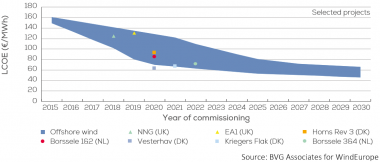UK offshore wind prices drop 50% in two years; GE unveils 4.8 MW onshore turbine
Our pick of the latest wind power news you need to know.

Related Articles
UK offshore wind prices plummet to 57.50 pounds/MWh
The UK government has awarded Dong Energy and EDP Renewables (EDPR) 15-year contracts for difference (CFDs) for two new UK offshore wind projects at prices of 57.50 pounds per MWh ($78.1/MWh), the UK government announced September 11.
The CFDs were half the price of contracts awarded in the last UK offshore wind tender in February 2015, highlighting how growing economies of scale, installation experience, and technology advancements are driving down costs.
In April, DONG Energy and ENBW became the first offshore wind power developers to acquire concessions at unsubsidized prices, bidding prices of zero euros per MWh to build wind farms in German waters.
Forecast offshore wind costs to 2030
(Click image to enlarge)
The latest UK prices were far lower than many expected and are highly competitive against the 92.50 pounds/MWh contract agreed for EDF's 3.2 GW Hinkley Point C nuclear power project in south-west England.
Dong Energy was allocated the CFD for its 1.4 GW Hornsea Project Two project off England's north-east coast, which will become the world's biggest wind farm project, surpassing Dong Energy's 1.2 GW Hornsea Project One windfarm currently under construction.
EDPR was awarded a CFD for its 950 MW Moray Offshore Windfarm (East) project in Scotland. France's Engie holds a 23% stake in the project.
Innogy and Statkraft were also allocated a contract for their 860 MW Triton Knoll offshore project off England's east coast, at a price of 74.50 pounds/MWh.
All three projects will be built in three phases. The first phase of the Triton Knoll project is scheduled to be completed in 2021-22. The first phases of the Hornsea Project One and Moray Offshore Windfarm projects are scheduled to be completed in 2022-23.
US launches offshore wind standards program to support growth
Leading U.S. energy and environmental authorities have launched an initiative to develop standards and guidelines for offshore wind power development, media reported September 13.
The new three-year initiative will use experience in wind, oil and gas and shipping sectors to produce national offshore consensus standards for commercial scale offshore wind development on the U.S. outer continental shelf (OCS) and state waterways such as the Great Lakes.
Falling costs in Europe are prompting US. offshore wind developers to raise growth outlooks but faster deployment will require accelerated supply chain and infrastructure support, company executives said at the U.S. Offshore Wind 2017 conference on May 8.
The new offshore standards initiative will involve representatives from the U.S. Department of Energy (DOE), the National Renewable Energy Laboratory (NREL), U.S. Bureau of Ocean Energy Management (BOEM), Bureau of Safety and Environmental Enforcement (BSEE), the Business Network for Offshore Wind, and the American Wind Energy Association (AWEA).
An Offshore Wind Technical Advisory Panel (OWTAP) of industry stakeholders will guide working groups to set out national standards which are recognised by the American National Standards Institute (ANSI).
Working groups will cover offshore compliance, geotechnical data requirements covering seabed soil and geology, ocean data requirements and floating offshore wind turbines.
“These standards and guidelines will form the basis for BOEM to establish transparent compliance requirements that will help industry in turn provide safe and reliable offshore wind facilities that serve the U.S. electric supply,” said Walt Musial, Principal Engineer at the National Renewable Energy Laboratory (NREL) and Chairman of the Offshore Wind Standards working group.
GE launches new larger 4.8 MW onshore wind turbine
GE Renewable Energy launched September 12 a new 4.8 MW turbine with a 158-meter rotor and tip height of up to 240 m.
The new turbine is GE's first turbine over 4 MW and is designed for low to medium wind speeds. The technology includes new high-tech plates, improved loads and controls and taller, more cost-effective towers, GE said in a statement.
Larger turbines with higher efficiency rates are driving down the cost of onshore wind power.
Wind experts predict the levelized cost of energy (LCOE) of onshore wind will fall 24% by 2030 as technology improvements drive a rapid increase in turbine capacity and hub height, according to an industry survey published by Berkeley Lab, the National Renewable Energy Laboratory (NREL) and University of Massachusetts in November 2016.
The wind industry must invest in innovative logistics and installation solutions to control costs associated with rising turbine dimensions and maximize deployment potential, industry experts told Wind Energy Update in June.
In the U.S., for example, there remains a limited number of the largest cranes, especially in regions with little wind power development or areas with high demand from other construction sectors.
New Energy Update

